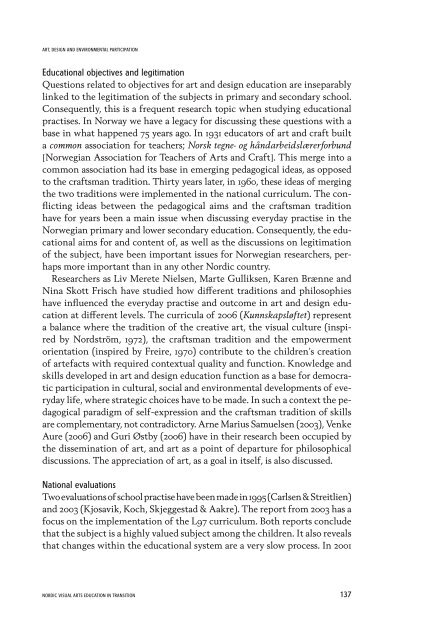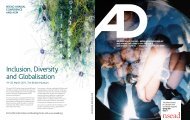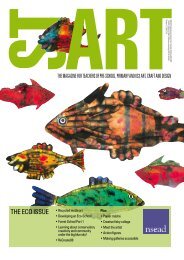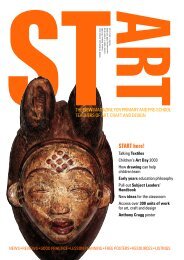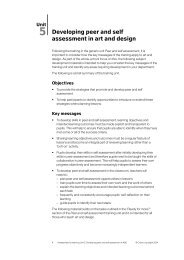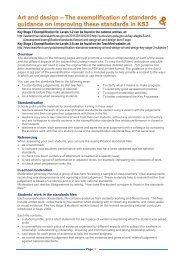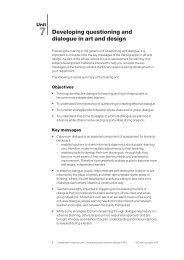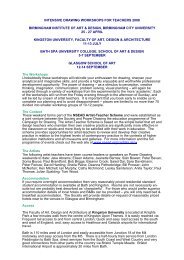Research in Visual Arts Education - Bilderlernen.at
Research in Visual Arts Education - Bilderlernen.at
Research in Visual Arts Education - Bilderlernen.at
Create successful ePaper yourself
Turn your PDF publications into a flip-book with our unique Google optimized e-Paper software.
ART, DESIGN AND ENVIRONMENTAL PARTICIPATION<strong>Educ<strong>at</strong>ion</strong>al objectives and legitim<strong>at</strong>ionQuestions rel<strong>at</strong>ed to objectives for art and design educ<strong>at</strong>ion are <strong>in</strong>separablyl<strong>in</strong>ked to the legitim<strong>at</strong>ion of the subjects <strong>in</strong> primary and secondary school.Consequently, this is a frequent research topic when study<strong>in</strong>g educ<strong>at</strong>ionalpractises. In Norway we have a legacy for discuss<strong>in</strong>g these questions with abase <strong>in</strong> wh<strong>at</strong> happened 75 years ago. In 1931 educ<strong>at</strong>ors of art and craft builta common associ<strong>at</strong>ion for teachers; Norsk tegne- og håndarbeidslærer forbund[Norwegian Associ<strong>at</strong>ion for Teachers of <strong>Arts</strong> and Craft]. This merge <strong>in</strong>to acommon associ<strong>at</strong>ion had its base <strong>in</strong> emerg<strong>in</strong>g pedagogical ideas, as opposedto the craftsman tradition. Thirty years l<strong>at</strong>er, <strong>in</strong> 1960, these ideas of merg<strong>in</strong>gthe two traditions were implemented <strong>in</strong> the n<strong>at</strong>ional curriculum. The conflict<strong>in</strong>gideas between the pedagogical aims and the craftsman traditionhave for years been a ma<strong>in</strong> issue when discuss<strong>in</strong>g everyday practise <strong>in</strong> theNorwegian primary and lower secondary educ<strong>at</strong>ion. Consequently, the educ<strong>at</strong>ionalaims for and content of, as well as the discussions on legitim<strong>at</strong>ionof the subject, have been important issues for Norwegian researchers, perhapsmore important than <strong>in</strong> any other Nordic country.<strong>Research</strong>ers as Liv Merete Nielsen, Marte Gulliksen, Karen Brænne andN<strong>in</strong>a Skott Frisch have studied how different traditions and philosophieshave <strong>in</strong>fluenced the everyday practise and outcome <strong>in</strong> art and design educ<strong>at</strong>ion<strong>at</strong> different levels. The curricula of 2006 (Kunnskapsløftet) representa balance where the tradition of the cre<strong>at</strong>ive art, the visual culture (<strong>in</strong>spiredby Nordström, 1972), the craftsman tradition and the empowermentorient<strong>at</strong>ion (<strong>in</strong>spired by Freire, 1970) contribute to the children’s cre<strong>at</strong>ionof artefacts with required contextual quality and function. Knowledge andskills developed <strong>in</strong> art and design educ<strong>at</strong>ion function as a base for democr<strong>at</strong>icparticip<strong>at</strong>ion <strong>in</strong> cultural, social and environmental developments of everydaylife, where str<strong>at</strong>egic choices have to be made. In such a context the pedagogicalparadigm of self-expression and the craftsman tradition of skillsare complementary, not contradictory. Arne Marius Samuelsen (2003), VenkeAure (2006) and Guri Østby (2006) have <strong>in</strong> their research been occupied bythe dissem<strong>in</strong><strong>at</strong>ion of art, and art as a po<strong>in</strong>t of departure for philosophicaldiscussions. The appreci<strong>at</strong>ion of art, as a goal <strong>in</strong> itself, is also discussed.N<strong>at</strong>ional evalu<strong>at</strong>ionsTwo evalu<strong>at</strong>ions of school practise have been made <strong>in</strong> 1995 (Carlsen & Streitlien)and 2003 (Kjosavik, Koch, Skjeggestad & Aakre). The report from 2003 has afocus on the implement<strong>at</strong>ion of the L97 curriculum. Both reports concludeth<strong>at</strong> the subject is a highly valued subject among the children. It also revealsth<strong>at</strong> changes with<strong>in</strong> the educ<strong>at</strong>ional system are a very slow process. In 2001NORDIC VISUAL ARTS EDUCATION IN TRANSITION 137


